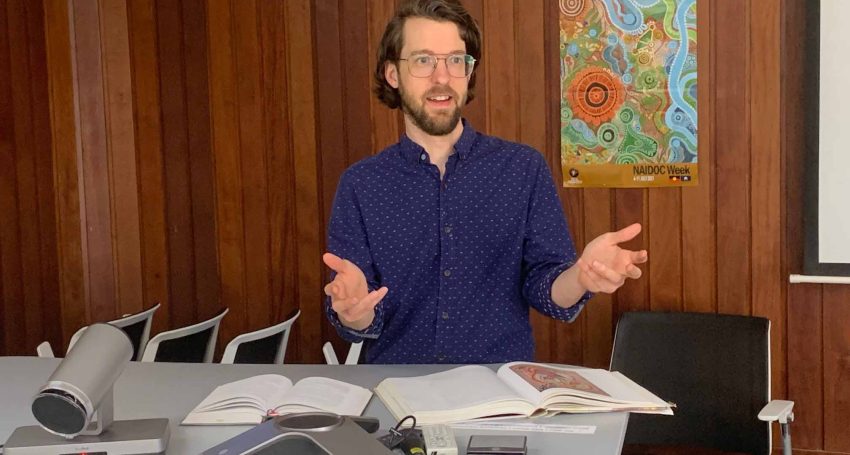Keeping the irony in atonement
Reflections
“So how do we talk about Jesus’ death in a way that keeps the irony necessary for a crucifixion to be good news? Perhaps we begin by leaving to one side all the theories and staying with the narratives in the gospels. The basic structure of those narratives is that Jesus returns from death and seeks out relationship with those who in one way or another participated in his death, starting with those most intimate to him,” says Dr Peter Kline from St Francis College

Every year in my class “Jesus the Christ”, I take students through various understandings of how Christians talk about sin and salvation, or “atonement” for short. While atonement theories have been important in the history of Christian thought, I must admit that they are not my favourite part of Christian theology. They tend to replace the rich complexity and dramatic irony of the gospel narratives with a too-tidy explanation of how Jesus’ death saves us from sin. As such, they lead us to focus on a certain theory about Jesus’ death, somewhat dismissing the transformative gesture of relating to Jesus’ death as our salvation. Think of the difference between having a theory about romantic love after reading a lot of novels or watching a lot of movies and saying “I love you” to an actual person. The former calculates something. The latter risks something.
Christian theology does a lot of calculating, especially in its atonement theories. For example, sin is spoken about as a “debt” and Jesus’ death is the payment of that debt. Or sin is spoken about as our being held in ransom by the devil and Jesus’ death is the payment of the ransom. Or sin is what kindles the wrath of God and Jesus’ death is the suffering of that wrath in our place. Each of these theories leaves me cold. What would it look like if Christian theology, rather than calculating a theory of salvation, risked itself in relation to Jesus’ death?
This would require theologians to echo or repeat the dramatic irony of the gospel narratives in their own writing rather than substituting in a tidy explanation. It would require forms of writing capable of drama and surprising reversal – of the sort that we find in the resurrection narratives in all four gospels. The point is not so much to understand something as to undergo something, namely, the shattering upending of tragedy into an unexpected and uncontrollable future:
Advertisement
“’Do not be alarmed; you are looking for Jesus of Nazareth, who was crucified. He has been raised; he is not here. Look, there is the place they laid him. But go, tell his disciples and Peter that he is going ahead of you to Galilee; there you will see him, just as he told you.’ So they went out and fled from the tomb, for terror and amazement had seized them; and they said nothing to anyone, for they were afraid” (Mark 16.6-8).
The dramatic irony of the gospel might be said like this: God takes the worst that human beings are capable of – torture, execution, scattering a community by killing a beloved member – and turns it into an occasion to savingly embrace us within God’s own life. Crucially, for the gospel to remain gospel (“good news”), God’s involvement in the crucifixion of Jesus must remain ironic rather than translated into a direct explanation or theory. The problem with atonement theories is that they tend to mute or completely silence this irony. Take, for example, that theory of atonement called “penal substitution” that says that Jesus saves us on the cross by suffering the wrath of God in our place. What this theory invites us to do is to look upon the murderous wrath of the Roman empire as the unironic revelation of God. God uses the violence of imperial torture and execution not to subvert violence from the inside, as it were, but to express God’s own violence toward sinners. What the theory does is install into the most iconic image of Christianity – Jesus on the cross – the union of human and divine violence. Human violence as the tool of divine violence. That is not good news. It is very bad news.
Advertisement
So how do we talk about Jesus’ death in a way that keeps the irony necessary for a crucifixion to be good news? Perhaps we begin by leaving to one side all the theories and staying with the narratives in the gospels. The basic structure of those narratives is that Jesus returns from death and seeks out relationship with those who in one way or another participated in his death, starting with those most intimate to him. In the Gospel of John, for instance, the disciples have locked themselves in a room out of fear following the crucifixion, and Jesus suddenly appears among them and says, “Peace be with you” (John 20.19). Now, those who like atonement theory will want an explanation of how Jesus’ death is the necessary condition for the peace he declares to his disciples: “Peace be with you [because I just paid a debt, ransomed the devil, suffered God’s wrath, etc.].”
But we get none of that. All we get is dramatic reversal. The horror and tragedy of crucifixion in which the disciples are involved – and then suddenly, the offer of peace. It is as if the crucifixion happened so that, at the extreme limits of human violence, Jesus, having suffered that violence, could return to his disciples and offer them peace, offer them himself, right at the point where it seems most unlikely, impossible even. Right at the point where Jesus is “made…to be sin” (2 Corinthians 5.21) where his flesh is condemned by the Romans and thus made devastatingly unholy according to Israel’s holiness codes (Deuteronomy 21.22-23) – right there, out of that fire, comes a peace that surpasses understanding (Philippians 4.6). There is no explanation here, no behind the scenes transaction, just the shocking arrival of grace and new life on the surface of the story. Out of devastation, ironically, comes new creation.
And importantly, that new life does not lift the disciples out of the story, but sets them to work within it, the way Jesus worked on his way to the cross. This is most clear in the ending of the gospel of Mark where the risen Jesus does not ascend into heaven, but returns to Galilee where his ministry began. There the disciples will find him as they walk the path he walked. They will not be saved from the tragedy and horror of life, but because of Jesus they may risk the work of love even amidst the fire.
Rather than taking the resurrection as an opportunity to theorise about Jesus’ death, let us take it as an invitation to risk ourselves in relation to it. Such risk looks like receiving salvation from Jesus by working to release signs of life, ironically, out of places where death and despair threaten to overwhelm. This is where we need theologians to help us see and think what this might mean in our varied contexts. Let me give one example. Remember, this is not an atonement theory. It is a witness to salvation in the details of a lived life.
In 2014, the Black theologian Stephen G. Ray Jr. took a trip to Ferguson, Missouri following the killing of Michael Brown by police officer Darren Wilson. As he witnessed the early gathering of the Black Lives Matter movement, what he saw was an unexpected arrival of grace. That grace was not what those familiar with certain Christian theologies might expect, namely, that officer Wilson could or ought to be forgiven because Jesus had paid the price for his sins. Rather, it was the community of solidarity and protest gathered by Michael Brown’s death that was the arrival of grace, a community where his killing became the occasion to enact a love for Black flesh that witnessed to God’s saving love for all of creation.
Reflecting on photos of Michael Brown he encountered in Ferguson, Ray writes, “What I was not expecting was that his eyes would draw me into an encounter with my own Black flesh that would invite me to experience it in a salvific way that I had not before…when I experienced the community called into being by the Spirit that was gathered precisely around Mike’s Black flesh, I knew that God has used his death to communicate something to us all. That communication? Simply put, in the unfolding of God’s salvific plan for all of creation, Black Lives Matter.”*
Ray is not theorising the atonement here, but risking an actual relation to Jesus’ death through the concrete realities of his context. Michael Brown’s Black flesh, condemned and made unholy by the powers of anti-Blackness, but embraced and celebrated by the community gathered around it, becomes Ray’s access to Jesus’ crucified and risen flesh. Jesus’ death is saving for Ray because Jesus’ resurrection is the unlikely promise that what is unholy and unloved in the world is the site where God’s unconquerable love dwells. The sign of that unconquerable love is a new community gathered by the Spirit and set to work.
Editor’s note: If you found this feature interesting and you would like to know more about studying theology at St Francis College, come to the St Francis College Open Day and find out about the wide range of study options. Visit the St Francis College website to register or for more information. The Open Day will be held on Saturday 4 June between 10 am and 12 noon.
If you are interested in studying “Jesus the Christ”, please contact Dr Peter Kline via pkline@ministryeducation.org.au.
* Stephen G. Ray Jr., “Black Lives Matter as Enfleshed Theology,” in Enfleshing Theology: Embodiment, Discipleship, and Politics in the Work of M. Shawn Copeland, ed. Robert J. Rivera and Michael Saracino (Minneapolis: Fortress Press, 2018), p.92.






